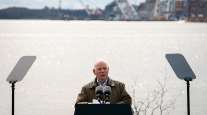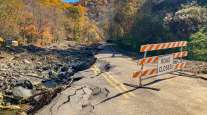$1.6 Billion Project Approved by Texas Transport Agency

After months spent hashing out how to pay the $1.6 billion tab, North Texas’ most pressing freeway need at long last gained the blessing of the Texas Transportation Commission at its May 24 meeting.
The Texas Department of Transportation now has its governing body’s approval to seek bids on 10.8 miles of Interstate 635 between Central Expressway and I-30 — known as LBJ East to planners. A contract will be awarded in the summer of 2019, and construction is expected to finish in 2024.
The result will be another free lane in each direction, continuous frontage roads that the 50-year-old freeway doesn’t have now and an improved interchange at I-30. The current HOV/Express Lanes in each direction, which are tolled, are “grandfathered” into the deal and will be rebuilt.
RELATED: Shuster to take another shot at infrastructure this summer
For years, regional planners said tolled lanes were the only way to fund the megaproject. In fact, they wanted to add two more of the optional lanes in expanding LBJ East. But tolls are no longer in favor with state leaders in Austin who, through the commission, drove months of negotiation.
Texas Sen. Don Huffines, (R-Dallas), told commissioners that the vote is “a victory set in motion when local leaders finally agreed to align their position with state leaders. We’re sick and tired of the congestion on 635.”
Huffines said later that the message to avoid building tolled projects was made clear in the 2017 legislative session. LBJ East was taken off the TxDOT to-do list by the state commission in December because it had tolled elements.
However, as late as mid-April, the Regional Transportation Council, a body of 44 elected officials which directs funds to local projects in the Dallas-Fort Worth region, had clung to plans for the road to be built with additional tolled, managed capacity alongside the extra free lane in each direction.
“This is a nontolled project,” TTC Chairman J. Bruce Bugg said at the May 24 meeting. “It had been on the books at the RTC as tolled. We can only advance nontolled.”
“It took a while for us to hear it and get there,” Cedar Hill Mayor Rob Franke, who as chairman of RTC was at the center of negotiations, told commissioners. “Thank you for not wavering and keeping the conversation going.”
Officials also praised residents who took an active role. Several Lake Highlands residents who are part of the LBJ Now movement and drove to Austin monthly to advocate for the project at TTC meetings were in attendance May 24 to witness what they considered a milestone.
RELATED: Houston joins smart cities program to prepare for autonomous vehicles
“LBJ Now is what happens when you get community members behind projects like this,” Christie Myers told the commission. “We’re still here. This impacts us every single day. And we will continue to be involved and participate in the process.”
“It’s advocacy,” resident Brad McCutcheon said afterward. “If you can get enough people and build momentum for something that affects their quality of life, you can get things done in Austin.”
B.J. Williams also was a repeat visitor to the commission’s podium. After six years of pushing for the freeway as a Garland City Council member, he said he felt a need to see LBJ East get pushed through.
“I felt it was critical for a Garland resident to be here,” Williams said. “This has been a very challenging, difficult narration started six-plus years ago. It looked dark.”
The revisions in LBJ East funding include TxDOT’s revised estimate that bids for the project will come in $200 million under what state commissioners considered, but didn’t act on, in January.
Huffines and state Sen. Bob Hall, (R-Edgewood), whose district also borders the freeway, said they will seek another specific change as TxDOT puts out requests for qualified contractors in the coming weeks.
Because there were space and plans for a configuration with five free lanes and two managed lanes in each direction, the senators said they would push for a switch to six free lanes with the grandfathered single managed lane in each direction.
“I think there would still be enough money for 14 lanes,” Huffines said.
Distributed by Tribune Content Agency, LLC




